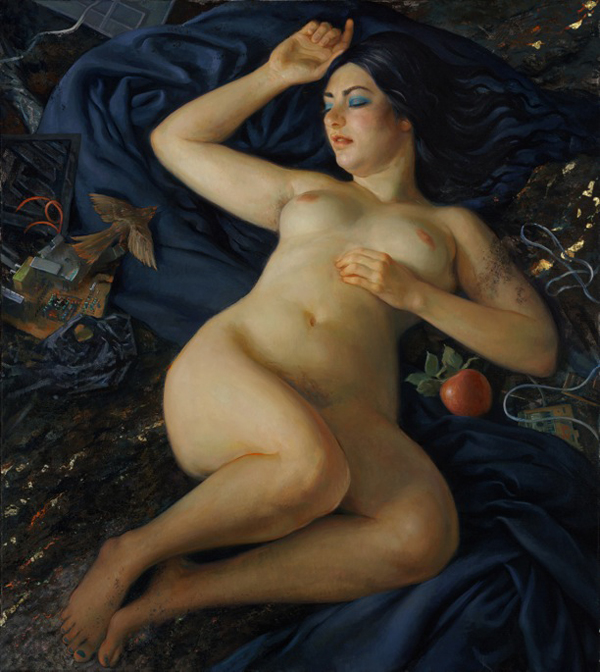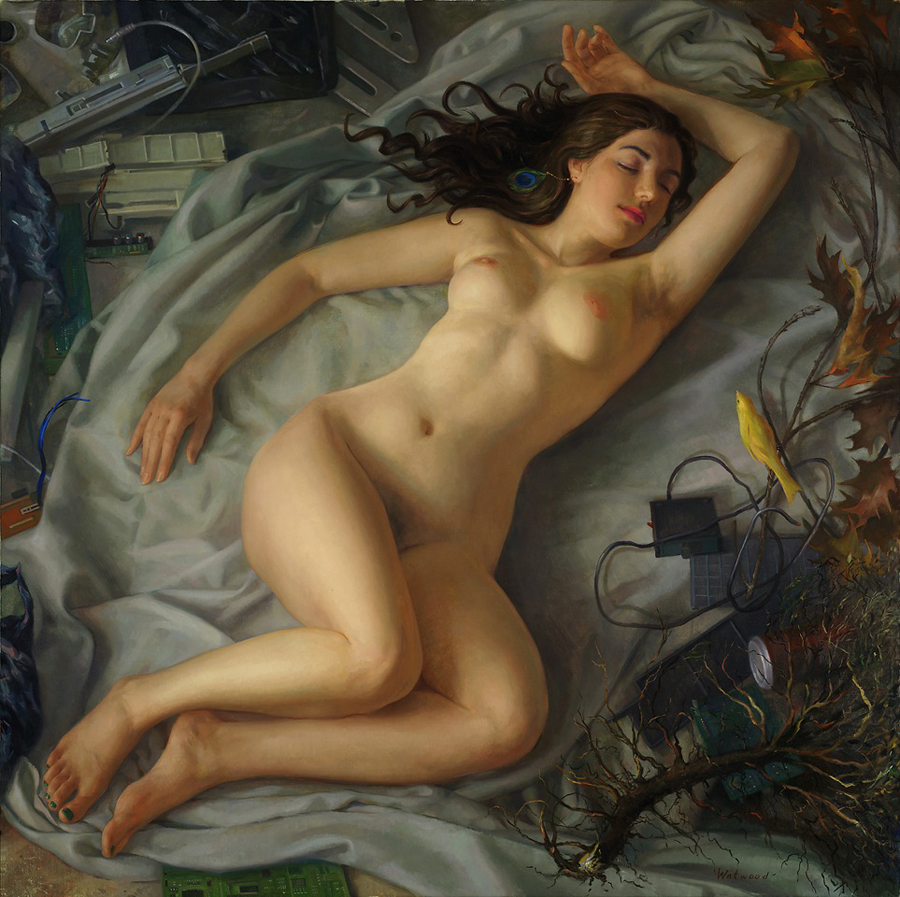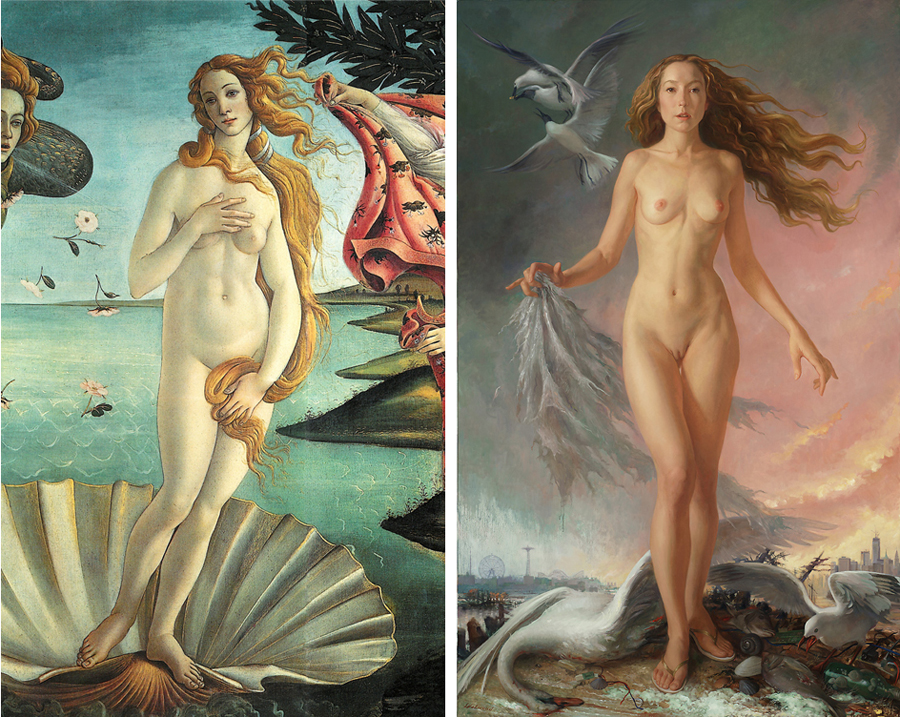Patricia Watwood, about whom I've written here before, has a new solo show, Venus Apocalypse, opening on Thursday at Dacia Gallery in Manhattan. Watwood is one of the most skilled figurative painters working in New York right now, and this show represents another stage of refinement in her large-scale project of fusing the visual syntax of classical allegory with contemporary themes.
While the project is constant, the means Watwood uses to pursue it evolve as she tests them. She has spent the past few years experimenting with richer color and more broken brushwork than she used earlier in her career. This transition is represented in the show by two extremely similar paintings: Venus Awakes, from 2011, and the 2013 Venus Sleeping:

In this first version, the oranges and blues are rich, the darks are saturated and the brushwork is visible, even in small reproduction -- note the construction of the figure's brightly lit thigh by adjacent passages of distinct bluish whites and creamy whites. Now here is Watwood two years later:

Notice how much more restricted the range of values is. The lights are dimmer, the darkest regions smaller. The colors have retreated from blue and orange to gentler cool-grays and warm-peaches. The brushwork is also smoother -- now the lit thigh is constructed from continuous transitions, not adjacent passages.
In a manner that reads to me as consistent with this evolution, the figure -- the same model, our beloved Leah -- has become longer and narrower. Watwood defines her own program in terms of maximizing beauty, and she is increasingly casting the eye of her idiom toward those painters most enraptured by formal beauty -- Tiepolo (G.B.), Watteau, and above all Botticelli. Like these ancestors, Watwood subscribes to a doctrine of capital-B beauty, beauty as Socrates would have understood it. She says:
In spite of its complicated relationship to feminism, I am singularly drawn to the image of female power and beauty ... Beauty is a great rhetorical tool. It can move people and change minds, and inspire action and devotion. Liberty Leading the People would not have been such a forceful, memorable, and motivating image if not for the great beauty of it. The beauty of the earth should inspire people to protect it, but humans are fatally anthropocentric. I think that figurative painting can bring emotional clarity to issues that otherwise might seem less urgent.
Watwood is articulating here a model of beauty as, ultimately, a technology of education, a tool of enlightenment. Beauty starts out by inspiring desire, but it focuses the mind slightly faster than it inspires the appetites. The mind becomes aware in confrontation with beauty: aware of itself and of the world. It is led to discipline -- it overcomes desire -- and it reaches at last toward its vast spiritual potential.
Of all the practitioners of beauty Watwood studies in her own pursuit of it, she is probably most sympathetic with Botticelli, as the title of the show indicates. Let's set the title painting alongside its inspiration:

RIGHT: Patricia Watwood, Apocalypse Venus, 2013, oil on canvas,??64" x 40"
The similarities and differences are instructive. Watwood's evolution toward milder color has brought her back toward the luminosity of Botticelli's tempera. She gracefully transposes the pink cloth on the right of Botticelli's painting into pink dawn light in her own. She has replicated the hair of Botticelli's Venus, and adjusted her model's vertical proportions to nearly match those of Botticelli's superhero-tall figure.
Differences, though, abound. Where Botticelli's Venus represents his idiosyncratic modification of a Grecian ideal, Watwood's expresses our contemporary fixation on adolescence, fitness and anorexia. She's much thinner than her Renaissance counterpart. While the classical female nude not only lacks pubic hair, but genitals, Watwood's nude lacks pubic hair in the finicky, quasi-pornographic way of urbane New Yorkers.
And, of course, the two goddesses occupy jarringly different universes. Botticelli's Venus comes from the beginning of the world, the age of dawn, of warm waters, gentle breezes, clear skies and fertile soil. Watwood's Venus is also sighted at dawn, but it is the dawn of the last day: the water is poisoned, the wind is high, the dark sky swirls into a hurricane and the soil is strewn with rubbish and dead things. Hence her flip-flops.
Watwood's statement decodes her use of the attention-focusing mechanism of formal beauty: "The beauty of the earth should inspire people to protect it, but humans are fatally anthropocentric." She has turned to the oldest of religious mechanisms -- personification of abstract natural forces as human-like gods -- to focus her concern into a form amenable to comprehension, and sped on its way to the viewer's reason by means of beauty.
We struggle in viewing this, as Watwood struggles in creating it, to set aside our empirical literalism and embrace an age-old ritual gradually displaced by the ages of the steam engine, the telegraph, the atom and the modem. We aren't quite there yet, and I don't think she is either. These are dispatches from a little past the midpoint of a project. For all that, they are gaspingly strange images. Watwood has gone right on stubbornly bashing her head against the stale and the fossilized, and the shell is starting to crack, the stiff materials to become warm and malleable again.
I find that exciting. My religion is not Watwood's religion, but anytime an artist breaks down the gates of locked precincts -- be they very new, or very, very old -- that is an accomplishment worthy of celebration.
---
Venus Apocalypse
June 5th - July 7th, 2013
opening reception Thursday, June 6th, 6 p.m. to 10 p.m.
Dacia Gallery, 53 Stanton Street, New York, NY 10002
(917) 727-9383
Watwood interview excerpt via Fine Art Connoisseur
Botticelli's "Birth of Venus" via wikimedia.org
All other images courtesy Dacia Gallery
?
Follow Daniel Maidman on Twitter: www.twitter.com/Daniel_Maidman
"; var coords = [-5, -72]; // display fb-bubble FloatingPrompt.embed(this, html, undefined, 'top', {fp_intersects:1, timeout_remove:2000,ignore_arrow: true, width:236, add_xy:coords, class_name: 'clear-overlay'}); });
Source: http://www.huffingtonpost.com/daniel-maidman/gold-white-pink-indigo-patricia-watwood_b_3377750.html
stephon marbury the lion king suzanne collins cherry blossom festival nc state erika van pelt pat robertson
No comments:
Post a Comment
Note: Only a member of this blog may post a comment.